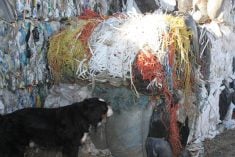Wheat streak mosaic broke out in two areas of western Saskatchewan, but local authorities think they have controlled it.
The disease appeared in winter wheat plots at the Swift Current Research Station and on a farm near Kindersley.
The Swift Current crops were plowed down. The Kindersley field has been left alone. An Agriculture Canada virologist thinks the disease probably won’t spread significantly in the standing crop, according to local agrologist Patty Robertshaw.
Government officials suggested the crop be plowed under, Robertshaw said, but the producer had treated the soil with Amber, so he had little choice but to grow wheat, so he left it alone.
Read Also

Message to provincial agriculture ministers: focus on international trade
International trade stakeholders said securing markets in the face of increasing protectionism should be the key priority for Canada’s agriculture ministers.
Saskatchewan Agriculture plant disease specialist Michael Celetti said other producers may have diseased crops and not know it. The symptoms may appear to be the same as from a nutritional deficiency, he said.
Local producers are advised to wait until local crops have dried for at least a week after swathing before they seed winter wheat. The disease is spread by mites that need green plant material for food.
Starve the mites
By letting the harvested crops dry out, the mites will starve and the next winter wheat crop can be planted with much less risk of infection, said Swift Current agrologist Jim Pratt.
There is no effective chemical control.
Celetti said the disease is endemic across the western Prairies, so the goal for producers is to manage it rather than attempt to eradicate the disease.
The disease tends to appear in and near winter wheat because those crops offer the disease mites a home to overwinter. It can also survive in volunteer cereals in broadleaf crops, and in volunteer wheat from recently harvested winter wheat. If the volunteers aren’t controlled, they can spread into newly seeded wheat crops, Celetti said.
The mite doesn’t fly, but is carried by the wind. That explains why it tends to be begin in one area and then slowly spread in the direction of the prevailing winds, he said. The earliest infected crops will be the most stunted.
Robertshaw said the Kindersley crop has a summerfallow buffer between it and the next crop, so the disease should be gone once the crop is harvested, she said.
“I think we got away lucky this year,” she said.















